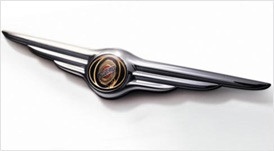I’ve been arguing for months that the government should not throw more bailout money at GM and Chrysler, but rather let them work out their problems in bankruptcy court. Filing for Chapter 11 bankruptcy protection would give the companies more leverage to modify gold-plated benefits and ruinous work rules that add approximately $2,000 in costs per car, compared with foreign automakers.
 Chrysler filed for Chapter 11 today. The government apparently has worked out a deal where the eventual result will be the UAW owns 55%, Fiat owns 35%, with the remaining 10% owned by some combination of the U.S. government and “secured” lenders. Neither the UAW nor Fiat are putting any new capital into the deal, but the U.S. government is committing up to $8 billion in additional financing, on top of the $4 billion the U.S. already has loaned Chrysler.
Chrysler filed for Chapter 11 today. The government apparently has worked out a deal where the eventual result will be the UAW owns 55%, Fiat owns 35%, with the remaining 10% owned by some combination of the U.S. government and “secured” lenders. Neither the UAW nor Fiat are putting any new capital into the deal, but the U.S. government is committing up to $8 billion in additional financing, on top of the $4 billion the U.S. already has loaned Chrysler.
So for up to $12 billion, some of which theoretically may be repaid, the government gets some portion of 10% of America’s least healthy automaker. The eventual value of the government stake is anybody’s guess, but since it’s easy to mix up million-billion-trillion-zillion, let’s do an order of magnitude comparison. As of mid-day today, the stock market values Ford — America’s healthiest automaker, far larger than Chrysler, and the only one of the Big Three that has not taken government bailout money — at about $14 billion, for 100% of the company.
Meanwhile, the UAW, whose members have enjoyed unsustainably high wages and benefits for decades, will own 55% of the reorganized Chrysler. Chrysler effectively will be a subsidiary of the UAW, which will sit on both sides of the table during future contract negotiations.
Mickey Kaus argues that this may be a good thing (he’s talking about GM, but the principal holds for Chrysler as well):
The union’s ownership so does not seem a problem. It seems a virtue. Let the UAW, as new owner of GM, pay the price for the overgrown work rules of its locals. Let the UAW demand above-market raises from itself. Let the UAW try to raise money from new lenders after the previous round of lenders has been royally screwed (thanks, in part, to the UAW). And then let the UAW try to sell the cars that result.
The most efficient way to balance competing interests, as Michael Kinsley noted years ago, isn’t an adverserial system where various singleminded interests duke it out–either in court or on picket lines–but in the head of a decisionmaker who will feel the relevant consequences. As long as the government steps out of the financing picture, the UAW will feel the consequences of its own excesses. Just don’t bail them out again!
That last sentence is where Mickey’s theory breaks down, I’m afraid. (I call him Mickey because he linked to me once.) He mocks a column by the Wall Street Journal‘s Holman Jenkins, but I think Jenkins (who has never linked to me) has the better argument:
In a real bankruptcy, which is the natural fate of companies unable to meet their obligations, Chrysler and GM would be run (or liquidated) for the benefit of their creditors, not their workers. But, here, “pattern bargaining” will remain the law of the Detroit jungle. The UAW will continue to use its unnaturally augmented clout to extract uncompetitive pay and benefits (it can do no other given its internal incentives). As it has for 40 years, Washington will pitch in with one improvisation after another, disguised as energy policy, trade policy, health-care policy or environmental policy, to stop the rivets from popping off. Politics, especially Democratic electoral politics, will play a more dominant role than ever.
What about those creditors, who would be first in line in a “real bankruptcy”? The big bondholders were all on board, but some of Chrysler’s smaller “secured” creditors refused to accept a deal that would have kept the automaker out of bankruptcy court.  Theoretically, the “secured” creditors could hold out for a liquidation of Chrysler, which might be a better deal for those creditors. The Automaker-in-Chief is aware of this, and Obama had this to say today:
While Obama voiced his support for Chrysler and the deal with Fiat, he was pointed in his criticism of the investors who did not agree to this deal.
“I don’t stand with them. I stand with Chrysler’s employees and their families and communities,” the president said. “I don’t stand with those who held out when everybody else is making sacrifices. That’s why I’m supporting Chrysler’s plans to use our bankruptcy laws to clear away its remaining obligations.”
Gulp. This is why I use scare quotes around “secured” creditors. Somehow I think the reluctant creditors will come around to seeing things Obama’s way.
Leave a Reply